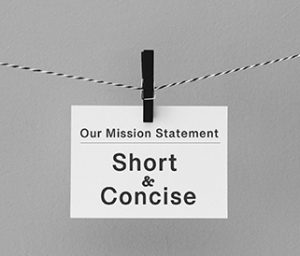Developing a Mission Statement
A mission statement clearly states what the organization does or why it exists. Mission statements are set in the present tense and explain the primary objective(s) of the organization, both to members of the organization and to people outside it. They should be short, clear and plausible. It’s important not to confuse the mission statement with a vision statement. A vision statement looks towards the future and states where an organization wants to be in five, ten, or more years later. Vision statements are often longer than mission statements. When crafting a mission statement, a system should consider its purpose. Defining a system’s purpose helps to clarify what aspects of the business are important to incorporate into the mission statement. The mission statement often answers a combination of basic questions about the organization:
- Who does the organization serve?
- What does the organization do?
- Why does the organization do it? [optional]
- How does the organization do it? [optional]
 Broadly defined, drinking water utilities are in the business of providing safe, reliable drinking water at an acceptable pressure. Wastewater utilities are in the business of treating and discharging wastewater in an environmentally sound manner. Stormwater utilities are in the business of capturing and cleaning runoff. Systems can use these broad definitions to help craft their individual mission statement(s). Changing the mission statement or creating an organization’s first mission statement is a process of gathering ideas and suggestions for the mission and honing them into a short, sharply focused phrase that meets specific criteria.
Broadly defined, drinking water utilities are in the business of providing safe, reliable drinking water at an acceptable pressure. Wastewater utilities are in the business of treating and discharging wastewater in an environmentally sound manner. Stormwater utilities are in the business of capturing and cleaning runoff. Systems can use these broad definitions to help craft their individual mission statement(s). Changing the mission statement or creating an organization’s first mission statement is a process of gathering ideas and suggestions for the mission and honing them into a short, sharply focused phrase that meets specific criteria.
While some companies have mission statements that are paragraphs long, the SW EFCSouthwest Environmental Finance Center recommends keeping the mission statement to one sentence. Keeping it short and concise makes it easier to communicate to the public and easier for the staff and public to remember. Avoid using buzzwords and jargon. Both are generally ineffective and add unnecessary length. When the SW EFCSouthwest Environmental Finance Center developed its mission statement, it involved the entire team since it is not a large organization. The SW EFCSouthwest Environmental Finance Center used a simple mission statement process that has been used by the SW EFCSouthwest Environmental Finance Center to help develop mission statements for other organizations.
- Divide everyone into small groups (3 to 5 depending on the total number of people.)
- Individually brainstorm words that come to mind when thinking about the organization and write them on sticky notes (one word per note.)
- As a small group, categorize the words into 3 to 6 categories and give each category a name. Place the sticky notes on a paper with the category name at the top.
- Using the category names, craft a mission statement that encompasses each category name. It can also include ideas from the sticky notes but does not (and should not) include all of the words.
- Each small group shares the mission statement it created with the larger group.
- The larger group votes on the preferred mission statement (a secret vote is best here.)
- The winning mission statement is examined further to see if any of the ideas from the mission statements not selected need to be incorporated into the selected mission statement.
- Final wordsmithing is completed to ensure that it embodies the qualities of a good mission statement and clearly meets the needs of the group.
- By the end of the process, a final consensus is reached regarding whether the mission statement is acceptable to all.
Southwest Environmental Finance Center Mission Statement:
“We promote self-reliance through innovative training and assistance focused on actionable results”
The whole process takes only about an hour, even if it is a large group. This process can work for any size system as the participants can be divided into smaller groups for the brainstorming and initial mission statement writing process described above. It is best if employees are not put into groups based on their role, but rather are mixed up to include different perspectives in each group. The mission statement can also be developed by a subset of the employees using this same process, but it would be important to ensure that all perspectives are represented.
When the mission statement has been finalized, systems should publicize it through internal and external communications and programs. A mission statement’s value comes from its use as an interface with the community, as an aid in goal setting, and as a motivational tool for staff at all levels. A system’s mission statement should be displayed everywhere, including letterhead, billings, signs, and advertisements. A well-thought-out mission statement can provide vision and direction for at least ten years. Generally, mission statements should not need to be revised unless the mission statement loses some of its relevance, no longer speaks to staff, board members, or customers, or the mission of the organization changes. Below is a graphic to illustrate the different components of a good mission statement versus a bad mission statement from nonprofithub.org. After the mission statement is created, the system is ready to develop Level of Service goals.

Source: nonprofithub.org